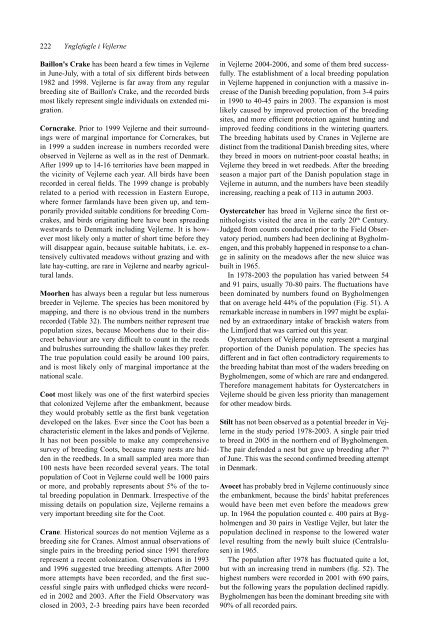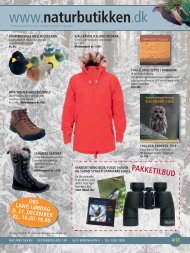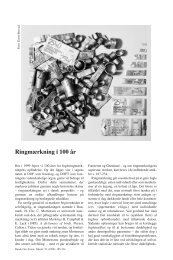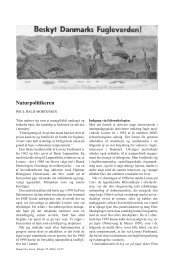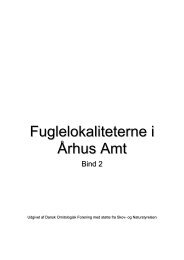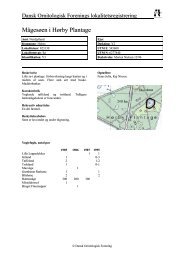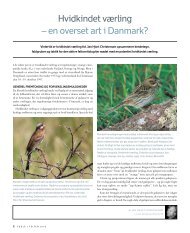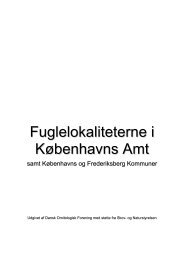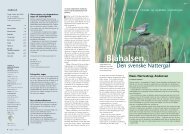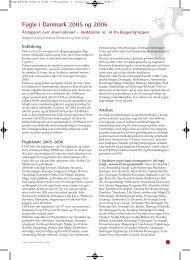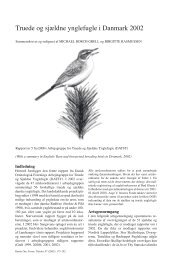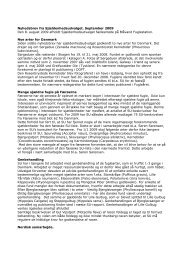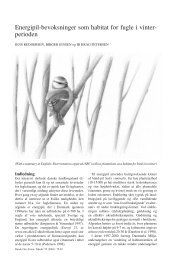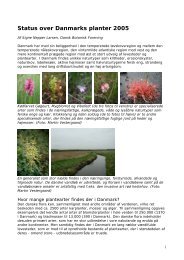Ynglefugle i Vejlerne - Dansk Ornitologisk Forening
Ynglefugle i Vejlerne - Dansk Ornitologisk Forening
Ynglefugle i Vejlerne - Dansk Ornitologisk Forening
You also want an ePaper? Increase the reach of your titles
YUMPU automatically turns print PDFs into web optimized ePapers that Google loves.
222 <strong>Ynglefugle</strong> i <strong>Vejlerne</strong><br />
Baillon's Crake has been heard a few times in <strong>Vejlerne</strong><br />
in June-July, with a total of six different birds between<br />
1982 and 1998. <strong>Vejlerne</strong> is far away from any regular<br />
breeding site of Baillon's Crake, and the recorded birds<br />
most likely represent single individuals on extended migration.<br />
Corncrake. Prior to 1999 <strong>Vejlerne</strong> and their surroundings<br />
were of marginal importance for Corncrakes, but<br />
in 1999 a sudden increase in numbers recorded were<br />
observed in <strong>Vejlerne</strong> as well as in the rest of Denmark.<br />
After 1999 up to 14-16 territories have been mapped in<br />
the vicinity of <strong>Vejlerne</strong> each year. All birds have been<br />
recorded in cereal elds. The 1999 change is probably<br />
related to a period with recession in Eastern Europe,<br />
where former farmlands have been given up, and temporarily<br />
provided suitable conditions for breeding Corncrakes,<br />
and birds originating here have been spreading<br />
westwards to Denmark including <strong>Vejlerne</strong>. It is however<br />
most likely only a matter of short time before they<br />
will disappear again, because suitable habitats, i.e. extensively<br />
cultivated meadows without grazing and with<br />
late hay-cutting, are rare in <strong>Vejlerne</strong> and nearby agricultural<br />
lands.<br />
Moorhen has always been a regular but less numerous<br />
breeder in <strong>Vejlerne</strong>. The species has been monitored by<br />
mapping, and there is no obvious trend in the numbers<br />
recorded (Table 32). The numbers neither represent true<br />
population sizes, because Moorhens due to their discreet<br />
behaviour are very difcult to count in the reeds<br />
and bulrushes surrounding the shallow lakes they prefer.<br />
The true population could easily be around 100 pairs,<br />
and is most likely only of marginal importance at the<br />
national scale.<br />
Coot most likely was one of the rst waterbird species<br />
that colonized <strong>Vejlerne</strong> after the embankment, because<br />
they would probably settle as the rst bank vegetation<br />
developed on the lakes. Ever since the Coot has been a<br />
characteristic element in the lakes and ponds of <strong>Vejlerne</strong>.<br />
It has not been possible to make any comprehensive<br />
survey of breeding Coots, because many nests are hidden<br />
in the reedbeds. In a small sampled area more than<br />
100 nests have been recorded several years. The total<br />
population of Coot in <strong>Vejlerne</strong> could well be 1000 pairs<br />
or more, and probably represents about 5% of the total<br />
breeding population in Denmark. Irrespective of the<br />
missing details on population size, <strong>Vejlerne</strong> remains a<br />
very important breeding site for the Coot.<br />
Crane. Historical sources do not mention <strong>Vejlerne</strong> as a<br />
breeding site for Cranes. Almost annual observations of<br />
single pairs in the breeding period since 1991 therefore<br />
represent a recent colonization. Observations in 1993<br />
and 1996 suggested true breeding attempts. After 2000<br />
more attempts have been recorded, and the rst successful<br />
single pairs with unedged chicks were recorded<br />
in 2002 and 2003. After the Field Observatory was<br />
closed in 2003, 2-3 breeding pairs have been recorded<br />
in <strong>Vejlerne</strong> 2004-2006, and some of them bred successfully.<br />
The establishment of a local breeding population<br />
in <strong>Vejlerne</strong> happened in conjunction with a massive increase<br />
of the Danish breeding population, from 3-4 pairs<br />
in 1990 to 40-45 pairs in 2003. The expansion is most<br />
likely caused by improved protection of the breeding<br />
sites, and more efcient protection against hunting and<br />
improved feeding conditions in the wintering quarters.<br />
The breeding habitats used by Cranes in <strong>Vejlerne</strong> are<br />
distinct from the traditional Danish breeding sites, where<br />
they breed in moors on nutrient-poor coastal heaths; in<br />
<strong>Vejlerne</strong> they breed in wet reedbeds. After the breeding<br />
season a major part of the Danish population stage in<br />
<strong>Vejlerne</strong> in autumn, and the numbers have been steadily<br />
increasing, reaching a peak of 113 in autumn 2003.<br />
Oystercatcher has breed in <strong>Vejlerne</strong> since the rst ornithologists<br />
visited the area in the early 20 th Century.<br />
Judged from counts conducted prior to the Field Observatory<br />
period, numbers had been declining at Bygholmengen,<br />
and this probably happened in response to a change<br />
in salinity on the meadows after the new sluice was<br />
built in 1965.<br />
In 1978-2003 the population has varied between 54<br />
and 91 pairs, usually 70-80 pairs. The uctuations have<br />
been dominated by numbers found on Bygholmengen<br />
that on average held 44% of the population (Fig. 51). A<br />
remarkable increase in numbers in 1997 might be explained<br />
by an extraordinary intake of brackish waters from<br />
the Limfjord that was carried out this year.<br />
Oystercatchers of <strong>Vejlerne</strong> only represent a marginal<br />
proportion of the Danish population. The species has<br />
different and in fact often contradictory requirements to<br />
the breeding habitat than most of the waders breeding on<br />
Bygholmengen, some of which are rare and endangered.<br />
Therefore management habitats for Oystercatchers in<br />
<strong>Vejlerne</strong> should be given less priority than management<br />
for other meadow birds.<br />
Stilt has not been observed as a potential breeder in <strong>Vejlerne</strong><br />
in the study period 1978-2003. A single pair tried<br />
to breed in 2005 in the northern end of Bygholmengen.<br />
The pair defended a nest but gave up breeding after 7 th<br />
of June. This was the second conrmed breeding attempt<br />
in Denmark.<br />
Avocet has probably bred in <strong>Vejlerne</strong> continuously since<br />
the embankment, because the birds' habitat preferences<br />
would have been met even before the meadows grew<br />
up. In 1964 the population counted c. 400 pairs at Bygholmengen<br />
and 30 pairs in Vestlige Vejler, but later the<br />
population declined in response to the lowered water<br />
level resulting from the newly built sluice (Centralslusen)<br />
in 1965.<br />
The population after 1978 has uctuated quite a lot,<br />
but with an increasing trend in numbers (g. 52). The<br />
highest numbers were recorded in 2001 with 690 pairs,<br />
but the following years the population declined rapidly.<br />
Bygholmengen has been the dominant breeding site with<br />
90% of all recorded pairs.


